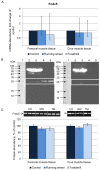Irisin is elevated in skeletal muscle and serum of mice immediately after acute exercise
- PMID: 24644429
- PMCID: PMC3957089
- DOI: 10.7150/ijbs.7972
Irisin is elevated in skeletal muscle and serum of mice immediately after acute exercise
Abstract
Recent findings regarding the response of fibronectin type III domain-containing protein 5 (Fndc5) and irisin to exercise are partly controversial. While the 25 kDa form of Fndc5 can be observed in muscle and serum of different species, the ~12 kDa irisin band was not detectable up to now. The present study aimed to clarify whether irisin exists in its theoretical size of ~12 kDa in mice and if it is affected by exercise. Male mice were randomly assigned to a sedentary control group (CO), a group with free access to running wheels (RW), and a treadmill group (TM). Blood and leg muscles were collected to investigate the regulatory cascade including peroxisome proliferator-activated receptor gamma co-activator 1-alpha (Ppargc1a) and Fndc5. In western blot analysis, antibodies were used capable of differentiation between full-length Fndc5 and irisin. This enabled us to demonstrate that irisin exists in muscle and serum of mice independent of exercise and that it is increased immediately after acute exercise. Different transcripts of Ppargc1a mRNA, but not Fndc5 mRNA, were up-regulated in the TM group. Furthermore, neither Fndc5 (25 kDa) nor Ppargc1a protein was elevated in muscle tissue. The Ppargc1a-Fndc5/irisin pathway did not clearly respond to mild exercise in the RW group. Our results provide evidence for the existence of irisin and for its immediate response to acute exercise in mice.
Keywords: Fndc5; Ppargc1a.; endurance exercise; irisin; myokine.
Conflict of interest statement
Competing Interests: The authors have declared that no competing interest exists.
Figures






Similar articles
-
SMAD3 negatively regulates serum irisin and skeletal muscle FNDC5 and peroxisome proliferator-activated receptor γ coactivator 1-α (PGC-1α) during exercise.J Biol Chem. 2015 Mar 20;290(12):7671-84. doi: 10.1074/jbc.M114.617399. Epub 2015 Feb 3. J Biol Chem. 2015. PMID: 25648888 Free PMC article.
-
Time-Dependent Changes in Increased Levels of Plasma Irisin and Muscle PGC-1α and FNDC5 after Exercise in Mice.Tohoku J Exp Med. 2018 Feb;244(2):93-103. doi: 10.1620/tjem.244.93. Tohoku J Exp Med. 2018. PMID: 29415899
-
Are skeletal muscle FNDC5 gene expression and irisin release regulated by exercise and related to health?J Physiol. 2013 Nov 1;591(21):5393-400. doi: 10.1113/jphysiol.2013.263707. Epub 2013 Sep 2. J Physiol. 2013. PMID: 24000180 Free PMC article.
-
From Skeletal Muscle to Myocardium: Molecular Mechanisms of Exercise-Induced Irisin Regulation of Cardiac Fibrosis.Int J Mol Sci. 2025 Apr 10;26(8):3550. doi: 10.3390/ijms26083550. Int J Mol Sci. 2025. PMID: 40332022 Free PMC article. Review.
-
FNDC5/Irisin System in Neuroinflammation and Neurodegenerative Diseases: Update and Novel Perspective.Int J Mol Sci. 2021 Feb 5;22(4):1605. doi: 10.3390/ijms22041605. Int J Mol Sci. 2021. PMID: 33562601 Free PMC article. Review.
Cited by
-
The Acute Effects of Swimming Exercise on PGC-1α-FNDC5/Irisin-UCP1 Expression in Male C57BL/6J Mice.Metabolites. 2021 Feb 16;11(2):111. doi: 10.3390/metabo11020111. Metabolites. 2021. PMID: 33669194 Free PMC article.
-
Irisin and Myonectin Regulation in the Insulin Resistant Muscle: Implications to Adipose Tissue: Muscle Crosstalk.J Diabetes Res. 2015;2015:359159. doi: 10.1155/2015/359159. Epub 2015 May 5. J Diabetes Res. 2015. PMID: 26075283 Free PMC article. Review.
-
Preclinical mouse models for assessing axial compression of long bones during exercise.Bonekey Rep. 2015 Dec 23;4:768. doi: 10.1038/bonekey.2015.138. eCollection 2015. Bonekey Rep. 2015. PMID: 26788286 Free PMC article.
-
The Role of Peptide Hormones Discovered in the 21st Century in the Regulation of Adipose Tissue Functions.Genes (Basel). 2021 May 17;12(5):756. doi: 10.3390/genes12050756. Genes (Basel). 2021. PMID: 34067710 Free PMC article. Review.
-
Mild-intensity physical activity prevents cardiac and osseous iron deposition without affecting bone mechanical property or porosity in thalassemic mice.Sci Rep. 2022 Apr 8;12(1):5959. doi: 10.1038/s41598-022-09997-x. Sci Rep. 2022. PMID: 35396390 Free PMC article.
References
-
- Besse-Patin A, Montastier E, Vinel C, Castan-Laurell I, Louche K, Dray C, Daviaud D, Mir L, Marques MA, Thalamas C, Valet P, Langin D, Moro C, Viguerie N. Effect of endurance training on skeletal muscle myokine expression in obese men: identification of apelin as a novel myokine. Int J Obes (Lond) 2013 doi: 10.1038/ijo.2013.158. - PubMed
-
- Boström P, Wu J, Jedrychowski MP Korde A, Ye L, Lo JC, Rasbach KA, Boström EA, Choi JH, Long JZ, Kajimura S, Zingaretti MC, Vind BF, Tu H, Cinti S, Højlund K, Gygi SP, Spiegelman BM. A PGC1-α-dependent myokine that drives brown-fat-like development of white fat and thermogenesis. Nature. 2012;481:463–468. - PMC - PubMed
-
- Brenmoehl J, Walz C, Renne U, Ponsuksili S, Wolf C, Langhammer M, Schwerin M, Hoeflich A. Metabolic adaptations in the liver of born long-distance running mice. Med Sci Sports Exerc. 2013;45:841–850. - PubMed

